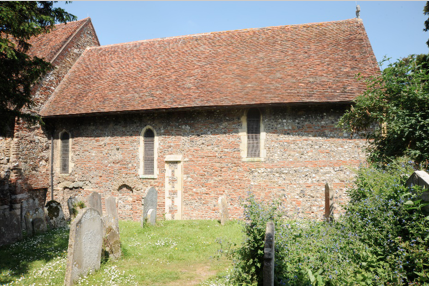About 65 members gathered at Lenham Community Centre on Wednesday 18th October 2023 to hear Paul Bennett, visiting professor at Christchurch Canterbury University and for many years director of the Canterbury Archaeological Trust, talk about Canterbury’s unrivalled legacy of Anglo-Saxon churches.
A substantial part of Paul’s lecture was devoted to a detailed examination of the fabric of St Martin’s, the oldest Christian church still in use in Britain. Much of the building dates from the 7th century and parts may survive from the church in which Queen Bertha worshipped before St Augustine’s mission. It is very moving to think that both Bertha and Augustine knew this building: of this we can be sure because Bede describes it.


The nave(above) and chancel(below) of St Martin, Canterbury
It is a peculiarity of Anglo-Saxon church planning, seen at Winchester, Glastonbury and other places as well as Canterbury, that a series of churches were built on an east-west alignment. West of St Martin’s lie in line three early churches: first, St Pancras, which is a ruin but contains much early fabric built of Roman brick, then St Mary, of which only a fragment survives and third St Peter and St Paul, built in 613, of which the lowest courses of the nave walls remain. Between these latter two churches is a Rotunda built by Abbot Wulfric of St Augustine’s Abbey in the mid-11th century to link them into a single structure. Still further west was the church of St John but of this nothing remains since the Norman crypt of the Cathedral occupies its site.
Apart from these extensive remains, it is clear that several of the city’s parish churches were of Anglo-Saxon origin. The most eloquent standing remains are at St Mildred, where the nave has cyclopean quoins which are clearly Saxon.

St Mildred, Canterbury: the SW corner of the nave
Paul Bennett displayed an understanding of, and feeling for, these churches which was profound. No one knows them better and it was a privilege to hear him sharing with us his passion for them.

